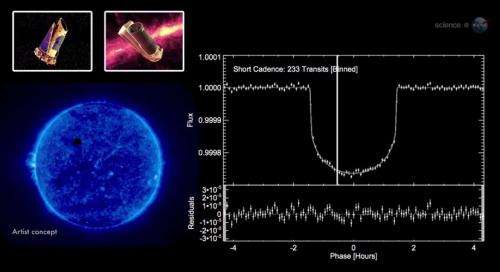Exoplanet measured with remarkable precision

Barely 30 years ago, the only planets astronomers had found were located right here in our own solar system. The Milky Way is chock-full of stars, millions of them similar to our own sun. Yet the tally of known worlds in other star systems was exactly zero.
What a difference a few decades can make.
As 2014 unfolds, astronomers have not only found more than a thousand "exoplanets" circling distant suns, but also they're beginning to make precise measurements of them. The old void of ignorance about exoplanets is now being filled with data precise to the second decimal place.
A team led by Sarah Ballard, a NASA Carl Sagan Fellow at the University of Washington in Seattle, recently measured the diameter of a "super Earth" to within an accuracy of 148 miles total or about 1 percent—remarkable accuracy for an exoplanet located about 300 light years from Earth.
"It does indeed seem amazing," says Ballard. "The landscape of exoplanet research has changed to an almost unrecognizable degree since I started graduate school in 2007."
To size up the planet, named "Kepler 93 b," Ballard used data from NASA's Kepler and Spitzer Space Telescopes.
First, Kepler discovered the planet. As seen from Earth, Kepler 93 b passes directly in front of its parent star, causing the starlight to dim during the transit. That dimming, which occurs once per orbit, is what allowed Kepler mission scientists to find the planet in the first place.
Next, both Spitzer and Kepler recorded multiple transits at visible and infrared wavelengths. Data from the observatories agreed: Kepler 93 b was really a planet and not some artefact of stellar variability. Ballard then knew that by looking carefully at the light curve she could calculate the size of the planet relative to the star.
At that point, the only missing piece was the diameter of the star itself.
"The precision with which we measured the size of the planet is linked directly to our measurement of the star," says Ballard. "And we measured the star using a technique called asteroseismology."
Most people have heard of "seismology," the study of seismic waves moving through the Earth. "We can learn a lot about the structure of our planet by studying seismic waves," she says.
Asteroseismology is the same thing, except for stars: The outer layers of stars boil like water on top of a hot stove. Those convective motions create seismic waves that bounce around inside the core, causing the star to ring like an enormous bell. Kepler can detect that "ringing," which reveals itself as fluctuations in a star's brightness.
Ballard's colleague, University of Birmingham professor Bill Chaplin led the asteroseismic analysis for Kepler-93 b. "By analyzing the seismic modes of the star, he was able to deduce its radius and mass to an accuracy of a percent," she says.
The new measurements confirm that Kepler-93 b is a "super-Earth" sized exoplanet, with a diameter about one-and-a-half times the size of our planet. Previous measurements by the Keck Observatory in Hawaii had put Kepler-93 b's mass at about 3.8 times that of Earth. The density of Kepler-93 b, derived from its mass and newly obtained radius, suggests the planet is very likely made of iron and rock, like Earth itself.
Although super-Earths are common in the galaxy, none exist in our solar system. That makes them tricky to study. Ballard's team has shown, however, that it is possible to learn a lot about an exoplanet even when it is very far away.
Provided by NASA




















